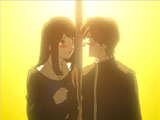

Quick Links:
RahXephon: Pluralitas Concentio
Often when my mind would switch to ponder mode - typically out of extreme boredom - I would arrive at the topic of how RahXephon came to be. Not so much the particulars, because anybody can read about those; but how someone might come up with a work like RahXephon, and how he might expect it to be received. At that point in anime history, Hideaki Anno had already stumbled through the creation of his eye-opening work, Shin Seiki Evangelion. Evangelion was obviously planned out meticulously, but ultimately relied on symbolism too much and plot consistency too little. It seemed so different from other shows, however, that fans forgave the mishap. What they didn't forgive was an ending that merely discussed the show's final hour, instead of displaying it for all to see. Fans didn't quiet on the matter until a movie was created that gave them what they wanted.
When Yutaka Izubuchi started with the creation of RahXephon, he merely had to watch his step on the stones that Anno stumbled on, or so I thought. What actually happened was a plot that was neglected in favor of symbolism - a true imitation of the earlier work. The implications of the symbolism changed from an escape from the self to a sort of bizarre ethnic cleansing, but the challenges each director would face seemed to be almost identical. The question becomes: How did this happen a second time? To recreate such a disjointed plot from the same basic structure - and with history on your side - you almost have to deliberately remove events from the plot that would have provided consistency and coherence. Perhaps Izubuchi felt that such confusion was Evangelion's real strength? Sure, and perhaps untold riches are buried in my backyard.
At any rate, this brings me to today's main topic - RahXephon's own motion picture: Pluralitas Concentio. RahXephon the series did not fail to provide enough visual cues to what was going on in its ending as Evangelion did; however, it did have a bit of difficulty with clearing the path leading up to that ending. Breaking it down, RahXephon is little more than a love-conquers-all story. There is no reason that its plot couldn't have played out more smoothly, and the movie simplifies it accordingly. Watching the film is not unlike recovering critical lost pages from a book - feeling relief that the full story has been uncovered, but also wondering why things happened that way.
The RahXephon movie will likely make zero sense to anybody who hasn't viewed the TV series, which is undoubtedly bad news for folks interested in seeing a condensed version of the show. The good news is: the TV series will make a lot more sense after watching the movie. The catch is: some things have changed. The plot is still mostly the same - wonder child Ayato Kamina gets called to his fate when Tokyo comes under attack by "otherworldly" forces - except his fate seems to be to steal a giant winged robot-thing and go fight for the bad guys until Tokyo Tower falls and the world ends. Okay, I made up that last part, I think.
This time, a couple characters are missing altogether, and some of the others have assumed slightly different roles. These changes are notable, but do not add value to the work or take therefrom - aside from the notion that the writers would go to any trouble to make the film worthwhile. The writers also cleaned up the character dialogue to make it more straightforward, and this change had a large impact. In fact, it's the biggest factor in the film's dramatic increase in watchability (over that of the series). The movie is not without its blunders, however. The fact that it dared to show an honest-to-goodness love scene would have scored the film points in my book - if it didn't look utterly ridiculous. Note to animators: love scenes are not the place to conserve frames. The movement of every hair and finger is vital to its effectiveness. By and large, though, the film carries the same high quality of artwork that the series did, and the writing is many leagues above.
The film's music is at roughly the same quality as the TV series, but the improved writing and direction makes it so much sweeter. The way in which all of the film's elements come together so beautifully brings a tear to my eye - especially given my distaste for how the series played out. The notable new addition in the music area is Tune the Rainbow, the ending tune performed by Maaya Sakamoto. It's not groundbreaking in terms of other Maaya music, but even her most average work tends to shine. The film's background music - in line with the series - is of exquisite taste and masterful execution.
As a supplement to its TV series, RahXephon's movie succeeds beyond what End of Evangelion was able to do for its series. The film simply does everything right: a consistent and coherent plot that accomplishes a purpose, dialogue that adequately supports the goals of the plot, and music that subtly exposes the beauty of the story. The film didn't need the series to build on, so much as the series needed the film to give it life.
Distributor: ADV Films Creator: Yutaka Izubuchi / Studio BONES Released: 2003
Plot: B+ Character Design: A- Animation Quality: B Music: A Overall: A-



